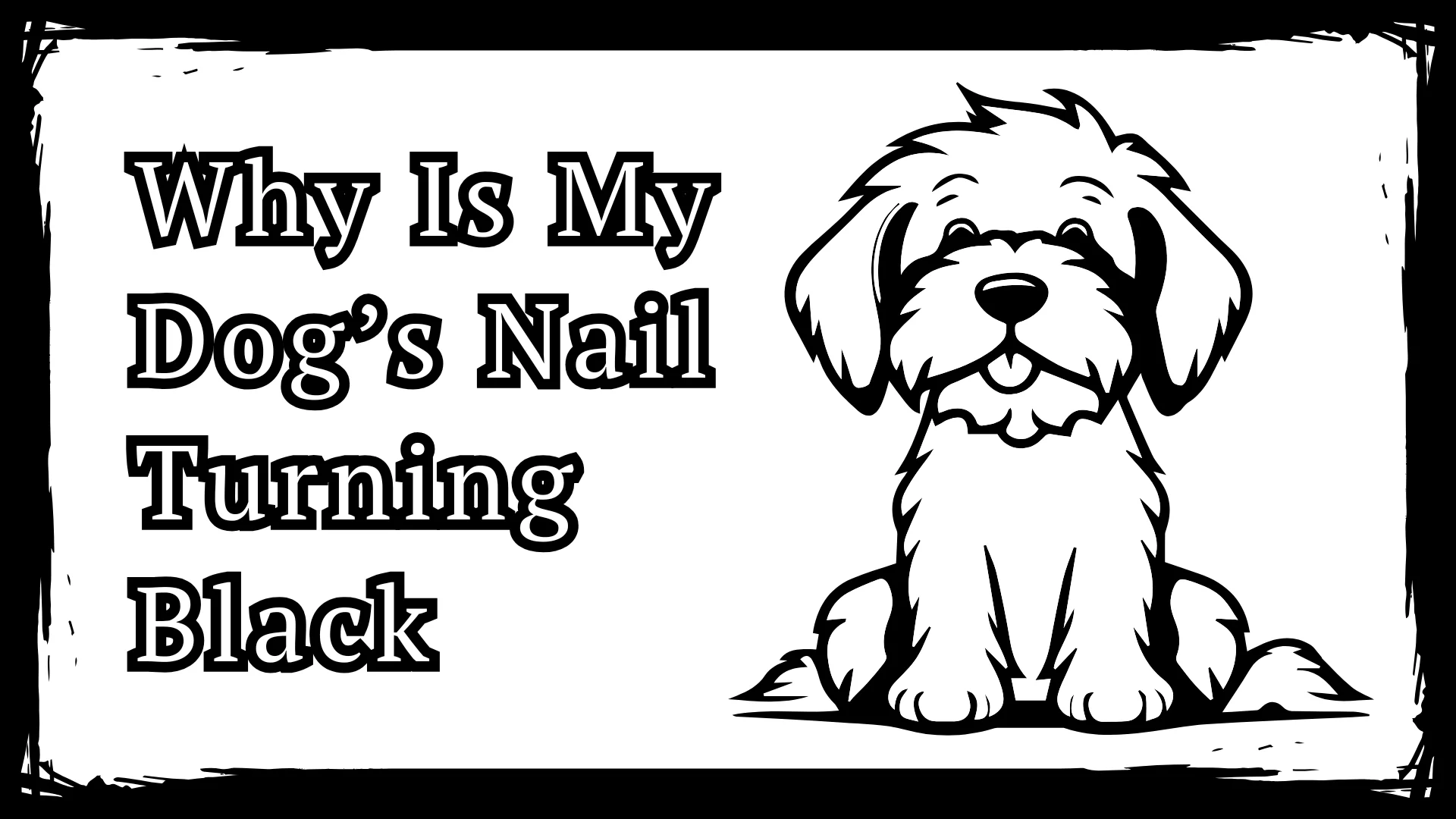Noticing your dog’s nail turning black can be confusing and even a little scary. But in many cases, it’s not serious. Nail discoloration can happen for several reasons, including age, breed, injury, or infection. Sometimes it’s completely normal—other times, it might need a vet’s attention.
A dog’s nail may turn black due to infection, trauma, or pigmentation. Bacterial or fungal infections and past injuries are common causes. Sometimes, it’s harmless pigmentation, but sudden changes should be checked by a vet.
This article explains the common causes, helpful treatments, and when to worry. By understanding the signs early, pet owners can keep their dog’s paws healthy, happy, and pain-free.
Also Read: Why Does My Dog Bite His Nails
Causes Of Dog Nails Turning Black
Understanding the cause is the first step toward comfort and treatment. Here are the main causes behind a dog’s nail turning black:
Age
Age-related pigmentation changes can cause dog nail discoloration, especially in senior dogs. Nails may naturally darken, thicken, or grow more slowly. While usually harmless, any sudden black toenail or pain in older dogs should be monitored and discussed with a veterinarian.
Breed
Some breeds naturally develop black or mixed-color toenails. Rottweilers, Labradors, and other dark-coated dogs often have genetically pigmented nails. This is normal and not a health concern unless the nail changes in shape, becomes brittle, or causes discomfort in your pet.
Trauma
Nail trauma from rough play, snagging, or hard surfaces can lead to internal bleeding or bruising, turning the nail black. Look for limping, excessive licking, or swelling. Damaged nails can become infected if untreated, so vet care may be needed.
Infection

Nail bed infections, either bacterial or fungal, can cause black nails in dogs. Symptoms include swelling, odor, discharge, and discomfort. These infections may result from cracks, injuries, or moisture buildup, and they require prompt veterinary treatment with antibiotics or antifungal medication.
Tumors
Canine nail tumors or melanomas can cause one or more nails to turn black, misshapen, or bleed. Though uncommon, they are serious and may spread quickly. Early veterinary diagnosis and treatment are essential to manage growths in or around the nail bed.
Solutions For Dog Nails Turning Black
Treatment depends on the cause. Infections need antifungal or antibiotic medication. Injuries require rest and gentle care. Regular trimming and paw hygiene help prevent issues. A vet should assess sudden color changes to rule out nail bed disease, trauma, or tumors in the affected toenail.
Why Is My Dog’s Nail Turning Black All Of
A sudden change could be due to trauma, fungal infection, or internal bleeding under the nail. If the nail becomes swollen, smells bad, or causes limping, it’s best to see a veterinarian. Sudden darkening isn’t normal and should be treated early to prevent complications.
Why Does My Dog Have Some Black Nails And Some White
Dogs can naturally have mixed nail colors, depending on their breed and coat color. It’s normal in breeds like Beagles or Boxers. As long as the nails are healthy and pain-free, having both black and white nails isn’t a sign of any medical problem.
Dog Nails Turning Reddish-Brown Treatment
Reddish-brown nails often result from excessive licking, moisture, or yeast infections. Clean the paws daily, use a vet-approved antifungal spray, and prevent licking with an e-collar if needed. If the nail smells bad or stays discolored, a veterinarian should check for a deeper infection.
Dogs Nails Turning Black At Base
When a dog’s nail turns black at the base, it could be an early sign of infection, nail bed inflammation, or trauma. Look for redness, swelling, or pain around the area. Keeping the paws clean and scheduling a vet check can help diagnose the issue.
Dog Nail Turning Black After Injury
Injuries can cause bruising or bleeding under the nail, turning it dark or black. This usually happens when a nail is cracked, stubbed, or pulled. Monitor for pain, limping, or licking. In most cases, the nail heals on its own, but deep injuries need vet care.
Dog Black Nail Treatment
Black nails caused by trauma or infection may require cleaning, medication, or nail trimming. In some cases, the nail might need to be partially removed. Keeping your dog’s nails short, clean, and free of cracks is the best way to prevent black nail problems.
Dog Black Toenail Limping
Limping with a black toenail could signal pain, infection, or a cracked nail. Dogs may lick the area or avoid putting weight on the paw. Rest, paw soaks, and a vet visit are key. Early care prevents worsening conditions like nail bed infections or abscesses.
Dog Black Nails How To Trim
Black nails are tricky to trim since the quick isn’t visible. Use a nail grinder or clip tiny amounts to avoid cutting too deep. Trim in good light and stop when you see a grey or pink circle. Regular trimming keeps nails healthy and pain-free.
Read More: Why Do Dogs Chew Their Nails
FAQs
Is it okay for dogs to have black nails?
Yes, black nails are normal in many dog breeds. Nail color depends on genetics and coat color. It’s only a concern if changes appear suddenly.
Is it normal for a dog to have a black toenail?
Yes, many dogs have naturally black toenails. It’s common and healthy unless the nail is cracked, painful, bleeding, or changes color unexpectedly.
What causes black nails on dogs?
Black nails can be caused by genetics, aging, trauma, or infection. Nail discoloration should be checked if it’s sudden or combined with swelling or pain.
What do unhealthy dog nails look like?
Unhealthy nails may appear cracked, swollen, bleeding, or discolored. Look for bad odor, limping, or excessive licking—these can signal infection or nail disease.
What does an infected dog’s nail look like?
An infected nail may be swollen, red, oozing, or smelly. The dog might limp, lick the paw constantly, or show pain when touched.
Can a dog’s nail heal on its own?
Yes, minor nail injuries may heal naturally. But deeper cracks, bleeding, or infection require veterinary care to avoid complications like abscesses or nail loss.
How to cut black dog nails?
Trim small amounts at a time. Use a nail grinder or sharp clippers. Watch for a grey center, and stop before reaching the sensitive quick.
Can a nail infection heal itself?
Mild infections might improve with rest and hygiene, but most need medication. Ignoring symptoms can lead to severe pain or nail bed damage.
What kills nail infections?
Veterinary-prescribed antibiotics or antifungal medication are best. Topical creams or medicated soaks can also help, depending on the infection type and severity.
How to fix a nail infection at home?
Clean the area with antiseptic, prevent licking, and monitor closely. Use vet-approved sprays or soaks. Always consult a vet if swelling or discharge worsens.
Conclusion
Black nails in dogs can look alarming, but they often have simple explanations, like natural pigmentation, age, or minor injury. However, changes caused by trauma, infection, or underlying health conditions should never be ignored. Knowing what’s normal and what’s not helps pet owners act quickly when needed.
Regular nail care, gentle paw checks, and prompt vet visits can keep your dog’s nails healthy and pain-free. Always watch for swelling, limping, or sudden color changes. With early attention and proper care, blackened nails can usually be treated easily, helping your dog stay comfortable, happy, and on their paws!




